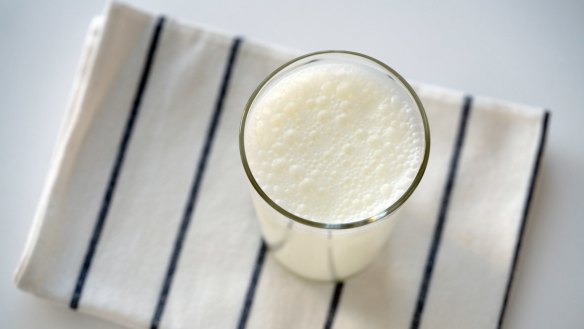What is buttermilk and what do you use it for?

Why use buttermilk? M. Glanville
Traditionally buttermilk was the liquid left over when cream was churned into butter. Today buttermilk is generally a manufactured dairy product in which concentrated, fat-reduced milk has a lactobacillus culture added to it. The culture turns lactose into lactic acid, which lowers the PH to about 4.5. The acid curdles the protein in the milk, making it slightly thick. Buttermilk is used in southern-fried chicken recipes as the acid helps denature the protein in the chook, making it more tender. Buttermilk pancakes are popular. Acid from the buttermilk reacts with baking soda to create carbon dioxide, which is trapped by the batter, making the pancakes light and fluffy.
I would like to know if there is an appliance, gadget or similar that will cut or slice my citrus fruits for marmalade. The trusty kitchen knife takes me ages, and never really gets the fruits thin enough. J. Drysdale
Every year I help MC the Red Hill Show. It's a little country show with a big heart in a small town where I went to primary school. I have the enviable task of working with the women from the Country Women's Association. The CWA is essentially a political lobby group pushing for better health, social and community services in regional areas under the deceptive cloak of scones, sponges, fruit cake and jam. "Good food brings people together at the table," former president Noela Macleod says. "There the important discussions can be had." She is a proponent of food that is properly cooked and cooked with a good dose of love. The disdain some of those women hold for those who use a food processor to chop their citrus fruit for marmalade is palpable. Their preferred marmalade is "fine cut". This means fine, thin strips of orange, preferably Seville orange, trimmed of pith, suspended in a bright amber-coloured jelly. Fine-cut marmalade is a work of art and takes a considerable amount of time. I have tried a very sharp mandolin in the past, but the skin of the oranges tends to tear. I have tried the slicing blade (not the chopping blade) of the food processor. The result is adequate, but I find it is hard to get evenly sized slices. I still find the best device is a freshly sharpened knife given a good touch-up with the steel between oranges.
Letters
Our mailbag here at the Brain Food Institute (head to the Ponds Institute and take the first left) is always overflowing. Here are a few of our recent favourite letters. From R. Clark comes, "When I was growing up in NSW, we always had superb bananas from Coffs Harbour. They had yellow flesh with a firm texture and a wonderful flavour. These mushy, white-fleshed examples we get today from Queensland are a poor version of 'the real thing' and are generally inedible in my opinion." This next one came from a very well-known chef who wished to remain anonymous. "In regards to creaming eggs and sugar in baking a cake, adding a little hot water to the eggs and sugar makes it easier to achieve a well-dissolved creamy foam. A tablespoon for an average cake will do."
Send your vexing culinary conundrums to brainfood@richardcornish.com.au or tweet or insta @foodcornish
Read more: Jill Dupleix's fried buttermilk chicken and corn recipe
- More:
- Food
- Brain food
